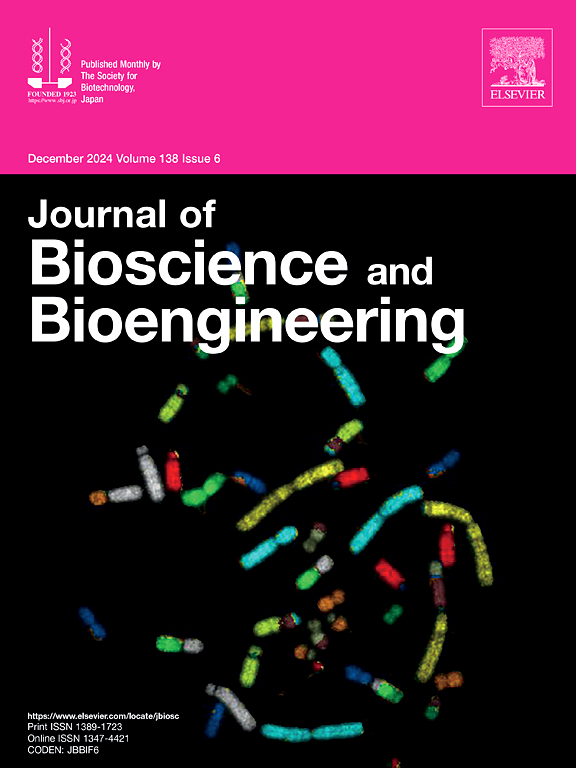利用培养上清液中细胞外囊泡的拉曼光谱评估诱导多能干细胞向神经祖细胞分化的情况。
IF 2.3
4区 生物学
Q3 BIOTECHNOLOGY & APPLIED MICROBIOLOGY
引用次数: 0
摘要
无创细胞培养监测技术对提高细胞产品的生产效率至关重要。我们发现,在人类诱导多能干细胞(iPSC)向多巴胺能祖细胞分化的过程中,细胞外囊泡(EVs)会分泌到培养上清液中,EVs的成分会随着分化过程发生变化。在本研究中,我们假设可以通过无标记拉曼光谱以非侵入性方式检测培养细胞分泌的EVs的成分变化,从而评估培养细胞的状态。iPSCs 培养是在标准条件(对照组)和人工偏差条件下同时进行的,人工偏差条件是通过消耗培养基中的 FGF2(-FGF2)来降低多能性,而 FGF2 是维持多能性所不可或缺的。随后,在相同条件下对每个培养的 iPSCs 进行分化。结果发现,在-FGF2条件下,多能性标志物NANOG的表达水平与对照组相比有所下降,并且与基于拉曼信号的鉴定结果相关,相关系数为0.77。脂质来源的拉曼信号被提取为鉴定因子,这表明细胞状态不同,EV 的脂质成分也会发生变化。综上所述,通过检测拉曼信号,我们发现培养上清液中 EV 成分的变化可作为细胞分化和多能状态的监测指标。本文章由计算机程序翻译,如有差异,请以英文原文为准。
Evaluation of induced pluripotent stem cell differentiation into neural progenitor cell using Raman spectra derived from extracellular vesicles in culture supernatants
Non-invasive cell culture monitoring technology is crucial to improve the manufacturing efficiency of cell products. We have found that extracellular vesicles (EVs) are secreted into the culture supernatants in the differentiation process from human induced pluripotent stem cells (iPSCs) to dopaminergic progenitor cells, and that the composition of EVs changes in accordance with the differentiation processes. In this study, we hypothesized that it is possible to evaluate the cultured cellular states by detecting compositional changes of EVs secreted from cultured cells with label-free Raman spectroscopy in a non-invasive manner. Therefore, Raman signal analysis derived from EV fractions isolated from culture supernatants throughout the differentiation process was conducted. iPSCs cultures were simultaneously implemented under a standard condition (control) and an artificial deviation condition inducing reductions in pluripotency by depleting FGF2 in culture medium (-FGF2), which is indispensable for maintaining the pluripotency. Subsequently, the differentiation step was conducted for each iPSCs culture under the same condition. As a result, it was found that under -FGF2, the expression level of the pluripotency marker NANOG decreased compared to that of the control and correlated with the identification results based on Raman signals with a correlation coefficient of 0.77. Lipid-derived Raman signals were extracted as identification factors, suggesting that changes in the lipid component of EV occur depending on the cellular states. From the above, we have found that the change in composition of EVs in the culture supernatant by detecting Raman signals would be a monitoring index of the cellular state of differentiation and pluripotency.
求助全文
通过发布文献求助,成功后即可免费获取论文全文。
去求助
来源期刊

Journal of bioscience and bioengineering
生物-生物工程与应用微生物
CiteScore
5.90
自引率
3.60%
发文量
144
审稿时长
51 days
期刊介绍:
The Journal of Bioscience and Bioengineering is a research journal publishing original full-length research papers, reviews, and Letters to the Editor. The Journal is devoted to the advancement and dissemination of knowledge concerning fermentation technology, biochemical engineering, food technology and microbiology.
 求助内容:
求助内容: 应助结果提醒方式:
应助结果提醒方式:


